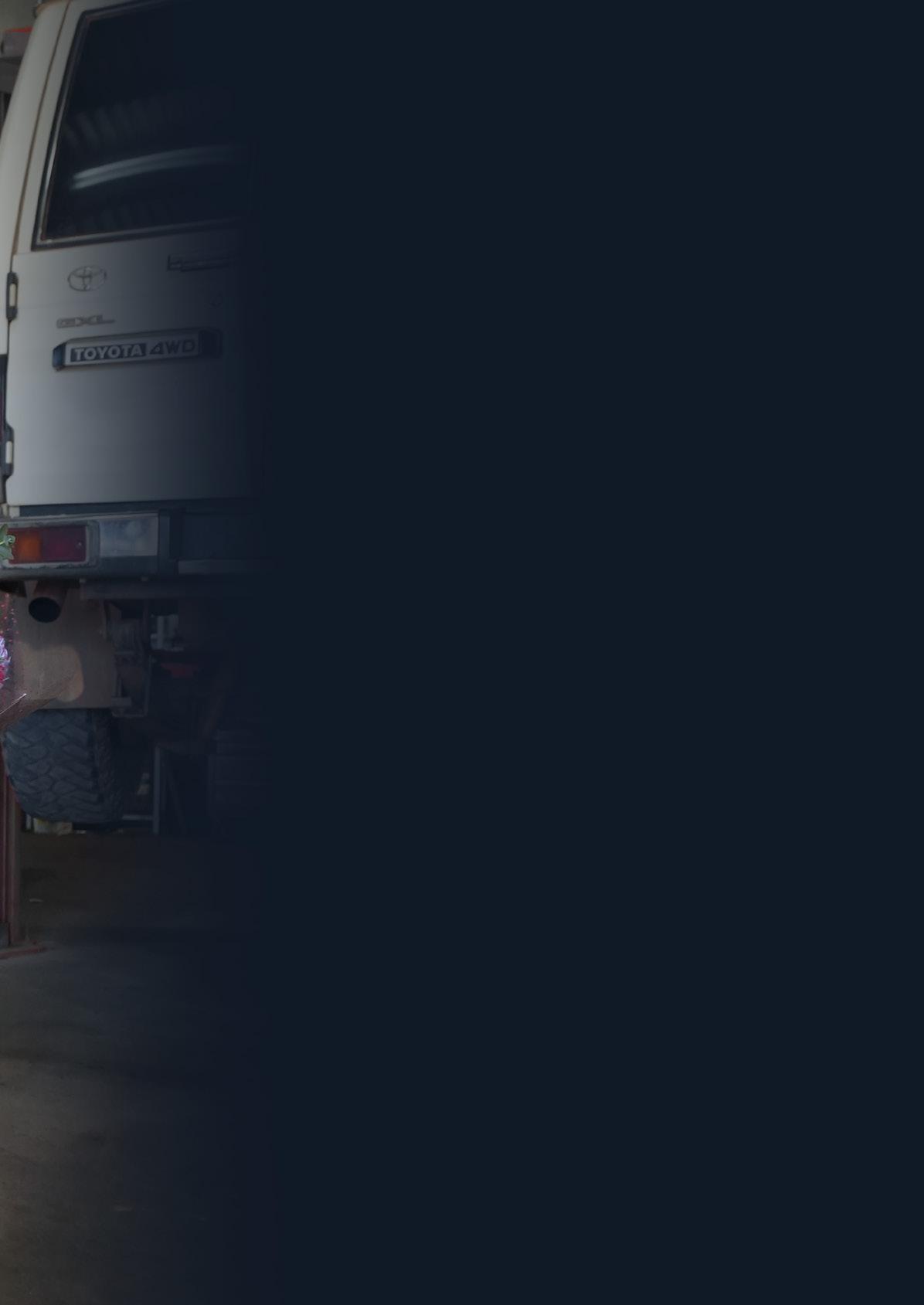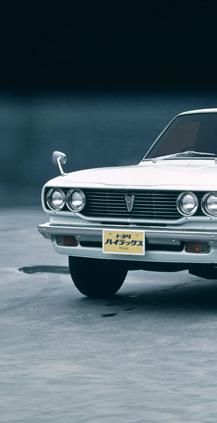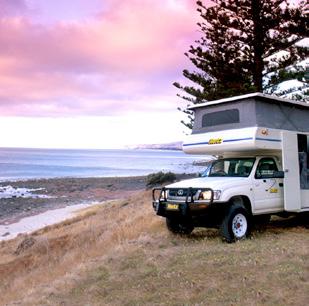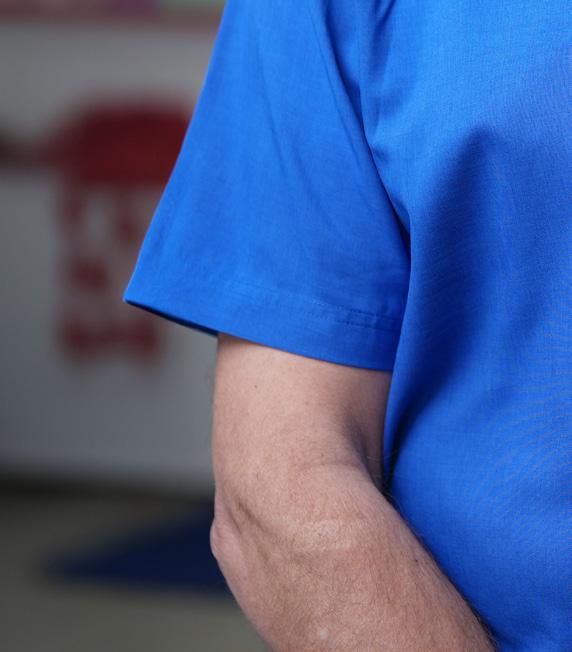








Queensland
Hervey





David Fraser Group CEO
Capricorn’s 50 celebrations kick into top gear this month, with the first of our 50 Years Strong-themed Gala Dinner & Tradeshows taking place in Sydney on 21 September. The Gala Dinner & Tradeshows then roll on to the other states and New Zealand, giving Members like yourself a wonderful and much needed opportunity to get together, swap war stories and let your air down.
These will be the last of the celebrations I will attend as Group CEO before I step down in December 2024 and hand over the reins to Brad Gannon. As you can imagine, I’m really looking forward to getting along to each of these events and catching up with a lot of friends and familiar faces from my 18 years with Capricorn and my long and enjoyable career in the auto industry. I hope you’ll come along to the Gala Dinner & Tradeshow nearest you. If you do, please come up and say hello.
While we’re celebrating, let me say a huge congratulations to the 2024 Capricorn Rising Stars Overall Winner, Megan Toia. The 21-yearold second-year apprentice from regional Western Australia beat an inspirational shortlist of five finalists, impressing judges with her commitment to her trade and her passion for the industry.
Megan comes from the wheat and sheep farming community of Moora, 200km north of Perth, and travels 60km to work at Badginarra Motors each morning. As I come to the end of my career it’s both reassuring and pleasing to see how enthusiastic and driven the young people just starting their careers are about the automotive industry. And I’m very proud of the role Capricorn has played in finding our future leaders, through the Capricorn Rising Stars Award.
Finally, next month is our Annual General Meeting, this year taking place on 26 October. The meeting will be hosted as a hybrid event allowing Members throughout Australia and New Zealand to vote and attend online. If you happen to be in the area (perhaps attending the WA Gala Dinner & Tradeshow) it’s a good opportunity to come in and see the our Head Office for yourself. Towards the end of September, all eligible Members will be sent an email providing further information, including where you can vote in advance, register to attend the AGM in person or virtually on the day.
I hope to see you very soon at one of Capricorn’s celebrations.

David Fraser Group CEO
FEBRUARY 2023
SEPTEMBER 2024
4 MEET MEGAN TOIA
The 2024 Capricorn Rising Stars Winner.
8 PERSONAL ACCIDENT AND ILLNESS PROTECTION
What happens to your workshop if you are ill or injured?
10 WORKPLACE CULTURE VS CUSTOMERS
Could your workshop’s culture be costing you business?
12 CLASSIC RIDE: TOYOTA HILUXHow Toyota’s workhorse ute became a family favourite.
16 IT’S ALL UPSIDE!
Chairman Mark Cooper reflects on 50 Years of Capricorn.
20 SECURING OUR INDUSTRY’S FUTURE TALENT
Getting young people excited about a career in automotive.
24 BUILDING A GREAT WORKPLACE CULTURE
The dos and don’ts you need to know about.


A second-year apprentice from a small regional WA town is this year’s Rising Stars Overall Winner.

The 21-year-old is a second-year apprentice from Badgingarra Motors in Western Australia’s Wheatbelt region, about 200 kilometres north of Perth. Megan said she was surprised and thrilled to win the industry’s top honour for outstanding apprentices in the automotive aftermarket.
“I’m trying not to let it go to my head,” Megan said. “It’s really blown my mind.”
Megan is passionate about automotive.
“I’ve always loved cars,” she said. “I’ve always loved how they sound, and have been interested in how they worked. I’m the middle child of five girls; I’ve always been a bit of a black sheep. I was always the more boyish of them all. I liked getting my hands dirty.”
Megan was nominated by her boss, Capricorn Member Harry Burgess, who said his apprentice is a hard worker who is an asset to his business and is set to become an asset to the entire industry. “She puts pressure on herself to complete tasks to a high standard and is very thorough,” he said in his nomination. “She carries out services and repairs independently and is learning very fast; she follows instructions and takes constructive criticism well.”
Megan’s passion for the industry, her love of learning and the way she continually strives for excellence impressed the panel of judges. More than 300 apprentices were nominated for this year’s award, with Megan coming out on top after three tough rounds of judging by industry experts.

Megan grew up in the wheat and sheep farming community of Moora (population: 1755), where she still lives. Every morning, she drives 60 kilometres to Badgingarra (population: 173) to get to work.
“Growing up in a small country town, there weren’t many opportunities for apprenticeships— especially for women,” Megan said. “No one was hiring.”
There are three workshops in Moora and about three more in surrounding towns—some more than an hour’s drive away. Megan had been working for two years at a recycling centre, in a job that she enjoyed but that offered no career, when she saw the advertisement for an apprentice at Badgingarra Motors.
“My mate was like, ‘Megan you would be all over this stuff—you love cars already; you love learning about stuff; this is your calling’,” she said. “So, I applied and it felt like a miracle when Harry called me up and asked me to come in for an interview.”
“He had me on the tools the first day; I got to help him take the transmission out of a big truck. That was fun. I quickly got to learn every part of a car, what the different tools are called. He was very patient with me when I made a mistake, walked me through what I did wrong. It was very refreshing. He had a lot of patience, which I’m grateful for.
money I need for it, I’d like to open my own shop one day, so I can employ people that typically aren’t well represented in the industry—people of colour, people of different sexual orientations, women—and just create a safe space for them. I’d really like to take the approach Harry has taken with his business where you take care of your customers because they’ll turn around and look after you.”
Megan said more should be done to support apprentices from regional communities.
“A big part of why I was hesitant to start an apprenticeship at first was because there isn’t a lot of support for regional and rural apprentices, especially when it comes to TAFE,” she said.
“The only TAFE that does block release, which means you go every couple of months for a week, is in South Perth. I’m quite lucky that I have my own vehicle and I’ve got places to stay in Perth where it won’t cost me money, but a lot of people don’t have that support, so the cost has to come out of their pocket. As every mechanic knows, you don’t get paid a lot in an apprenticeship, so that is definitely a struggle that thankfully I avoided.”

“I’m so glad that ‘past Megan’ applied for this job. I love every second of it. I would not be in any other profession. I wouldn’t do anything else.”
“I love the problem-solving. You get a car in and you have one piece of information and get to go through and figure it out and solve the problem.
I love the puzzles.”
So, what does the future hold for this year’s Rising Stars Overall Winner? She also has a particular interest in electric and hybrid vehicles but, like many young West Australians, Megan is also attracted by the opportunities offered by the mining industry.
“After I’m qualified, I might stay here for a year or two and then move on to the mines and do a trade upgrade to heavy diesel,” she said. “Then I’ll be dual qualified. Then, once I’ve earned the
Proudly sponsored by:

Megan said it’s more than a twohour drive from Moora to South Perth, making attending TAFE twice a week (rather than block release) impossible.
“I believe if there was more support for regional apprentices, it would not only benefit existing apprentices it would entice more to go into trades,” she said.
Capricorn thanks all Members who nominated their outstanding apprentices and supported them during the application process. Also, we take this moment to thank the 2024 Capricorn Rising Stars sponsors - Castrol, Repco, and The Workshop Whisperer - for their generous support and contributions. Thanks to them, Megan, the Top 5 Finalists, and their nominating workshops received recognition and fantastic prizes. We look forward to meeting next year's talented apprentices!









While workers’ compensation covers your employees if they are injured or become sick at work, there is no such compulsory protection for business owners.
Personal Accident and Illness Insurance fills that gap, ensuring a prolonged period without income doesn’t seriously impact your family, savings and lifestyle.
It generally covers capital benefits and the loss of weekly income as a result of accident or illness.
It may provide a lump-sum benefit amount if you are permanently disabled.
Accidents happen. If you get injured or ill and you’re unable to work, will your workshop keep running efficiently in your absence? Or will you be forced to shut the doors, with the resulting loss of income?
You can take sensible steps now to protect yourself financially from the expense and inconvenience of illness or injury.
There are often broad benefit period options from 12 to 24 months of cover.
In certain circumstances it may protect employees where Workers’ Compensation Insurance and Compulsory Third Party Insurance do not provide cover.
You are able to nominate the level of weekly gross wage or salary you want protected, to ensure you receive the level of income you need while ill or injured.
It may also include additional benefits to cover rehabilitation and activities outside of work hours.
You can personalise your cover to ensure it meets your precise needs! Choose:
Cover for an agreed weekly amount
24 hour or outside of working hours cover
Benefit periods from 12 to 24 months
The amount of excess paid before a claim is paid.

Customer service expert Chris Smoje shares his advice for diagnosing and fixing a culture that’s turning customers off.


Could your workshop’s culture be costing you customers?
Problems with culture might seem like an internal issue, but they can quickly affect your most important external relationships— with your customers and suppliers.
Perth-based customer service expert Chris Smoje, author of All-In Culture: Lead Your People to be of Service, said the things going on inside an organisation can quickly detract from what should be the big goal: solving problems for customers.
“Any business should be very aware of keeping the internal workings of an organisation as private as possible,” he said. “Customers don’t really need to know the organisation structure, who reports to whom, how clunky the IT system is, etc."
“But hiding culture is much more difficult.”
Internal politics, or a culture of bickering and blame, “has a way of finding its way out”, Chris said.
“Say a part hasn’t been ordered for a car but the parts team don’t get along with the service team and they choose not to communicate it. Then the service team book the car in, the customer drops the car off, only to be told later that the car can’t be serviced because there are no parts. In this example, the customer doesn’t learn of the ‘dysfunction’ between departments, they just have a negative experience because the culture found a way to leak out.”
When culture is positive, it will achieve the opposite of this example.
“The frictionless, easy experience then makes customers want to continually do business with the organisation,” Chris said.
“The other benefit of a positive culture is that it also makes the organisation attractive to work for and therefore there’s less turnover of employees.”
Chris said workshop owners wanting to diagnose their culture and the impact it’s having on customers should start by looking at what’s not being done right for customers the first time (perhaps causing a delay, a return or a complaint).
“Was it because of a breakdown of internal communication, teamwork, or an internal process or practice getting in the way of serving customers?” Chris said.
To improve the situation, Chris said workshop owners should consider these six points:
1. Do you actively think about hiring service-focused staff?
2. Is customer service training provided?
3. Are there frequent conversations about customers and service during meetings and briefings?
4. Are good service behaviours/moments publicly recognised?
5. Is customer feedback regularly monitored?
6. Do internal processes always consider the impact something has on the external customer?
“Too often organisations only pay attention to the easy metrics like Google reviews, which are lagging indicators to begin with but at the end of the day they are only a number that doesn’t often provide any further clues on what can be done to improve,” Chris said.
The good news is, you’re not stuck with a poor culture. Chris said it’s absolutely possible to turn things around.
“It’s not one of those things that gets fixed with a two-hour workshop and a big declaration by the boss,” he said. “Often some sort of help is needed to help navigate the organisation into the right direction. But most importantly it must come with a willingness to change and with strong accountability—plus a commitment to it in the long term.”
He recommends starting by asking the questions listed in this article and looking at the internal processes, policies and other complexities that might be compounding problems and getting in the way of good customer service.



















ou might think that a car manufacturer would shy away from claiming that one of its vehicles was invulnerable. It definitely didn't work out for Elon Musk at the now infamous launch of the Cybertruck and its not-so-shatterproof "Tesla Armour Glass".
But that's exactly what Toyota did with the Toyota HiLux - they promised the world that it was "unbreakable".But how did it get here?
The Toyota HiLux was first produced in Japan in 1968 as the RN10. Actually, built by Hino, it had a short wheelbase and a 1.5 litre inline-four engine.
The “lux” in the HiLux name was meant to indicate “luxury”. But, in reality, the HiLux was really only luxurious in the sense that it was a bit nicer than the Toyota Stout that preceded it. The HiLux also had the advantage of reliably getting you to your destination, the value which should not be underestimated.
Toyota immediately began tinkering with the design. A long wheelbase version was produced in 1969. A 1.6L version came out in 1971. A 2.0L automatic came along in 1972. Then a radical redesign in 1975 made the ute much larger and another, in 1978, introduced both four-wheel drive and dual cabs—the latter allowing owners to use a ute as a family vehicle for the first time.
All the while, its popularity grew.
First-generation HiLuxes had been imported to Australia for use in the construction and mining sectors as early as the late 1960s. The 4x4s of the third generation cemented the HiLux as the firm favourite of farmers, tradies, miners, weekend adventurers and hardworking men and women across the country.
By the fourth generation, the HiLux came with air conditioning, power windows and power locking systems, finally putting a little “lux” into HiLux.
Then, in 1988, the fifth generation gave us significantly more power, including 3.0L diesel and 3.0L V6 petrol options, as well as the latest tech—power steering and rear anti-lock braking.
As the HiLux became increasingly popular as a versatile family vehicle, Toyota continued to tinker with the design to make them more road friendly. The leaf-sprung front axles were replaced with independent suspension with torsion bars, the design was refined, safety features were improved.
The by now beloved HiLux was being marketed as “unbreakable” or, in some markets, “indestructible”. In 2003, the BBC’s smash hit car show Top Gear decided to put this claim to the test. In what must be the greatest example of free advertising any vehicle has ever received, Jeremy Clarkson and the team found increasingly ridiculous ways to try to destroy an already battered 1988 Toyota HiLux they’d bought from a farmer. It had 305,000 km on the clock. Clarkson drove it down stairs, slammed it into a tree, drowned it in an estuary, dropped it from a height, drove it through a shed, and dropped a caravan on it. After all this, the steering, the engine, the gearbox, the brakes: everything was absolutely fine. So, they slammed a wrecking ball into it. Then set fire to it. Clarkson couldn’t kill it. Finally, they put it on top of a 23-storey building being blown up for demolition. It rose from the dust—battered and bruised. Only the bodywork was holding the chassis together, but the engine still started and it was still driveable (although it’s safe to say it wouldn’t have passed a roadworthy test).
Thanks to Top Gear, the already popular HiLux had become a global icon.
In the more than 20 years since, Toyota has released the seventh and eight generations of the HiLux. The seventh got curvier and had a bigger engine (with a 4.0L option), but by popular acclamation lacked some of the power and handling that had helped build the model’s reputation. The eighth was a return to form—and truly luxurious, with all the gadgets from pre-collision systems and lane assist to infotainment and climate control. The more “lux”, the more the appeal of this once humble ute widened. The Rugged X and Rogue models—Australian-designed and engineered, if not built—were launched in 2018 as vehicles for “urban adventurers”. By now, the HiLux was king in Australia. It would remain the country’s top-selling car until 2023, when the Ford Ranger would replace it.
But what of the future? Can the HiLux regain its crown? With changes in Government legislation around polluting vehicles, the HiLux and all vehicles like it will have to switch to electric motors or face extinction.
Fortunately, Toyota has seen the writing on the wall. It has released the V-Active 48V, a hybrid HiLux with a 48-volt battery and a 2.8L turbodiesel engine.
Maybe the HiLux is immortal as well as unbreakable after all? Only time will tell.

CHAIR MARK COOPER REFLECTS ON 50 YEARS OF CAPRICORN.
We’ve got financial growth; we’ve got membership growth; we’ve got more things that we offer Members. We’re 50 years strong and we just keep getting stronger.”





Like many Members, Mark Cooper first heard of Capricorn not long after opening his business, when an industrious Area Manager knocked on his brand spanking new workshop door.
“I went into business in September 1995 and John Rundle, who was the Area Manager at the time, came to the workshop on what must have been my first or second day that I was open,” Mark said. “He said to me, ‘Are you a Capricorn Member?’ and I said, ‘What’s Capricorn?’
“He explained to me that you buy parts through your Capricorn account giving you the ability to purchase parts from hundreds of parts suppliers across Australia without having to apply for trade accounts with each individual supplier, you get Rewards Points and you can buy shares, you get dividends on your shares, and the other value propositions of Capricorn. And I said to him, ‘Well that sounds wonderful. What’s the downside?’ And he said, ‘There is no downside.’ So, I signed up pretty well as soon as I opened the door.”
Fast-forward almost three decades and Mark can not only tell you anything you want to know about Capricorn and how it operates and the value it provides to Members, he’s also played a big hand in guiding its development.

Mark is the director and owner of the Cooper Group which owns a number of automotive business brands in Tasmania including Cooper Automotive, which has a string of service centres under its banner. In October 2013, Mark joined the Capricorn Board as a non-executive director. In 2019, he became the Chair of the cooperative.
With all that insight, what does he make of Capricorn’s 50-year anniversary?
“It’s hard for a business to survive and thrive for a long period of time—and in the very early days Capricorn almost didn't make it.” he said.
“So, when I think of 50 Years Strong, I think of surviving those near-fatal wounds in the early days, where they almost went ‘let’s call it quits’, and then being able to grow into a financially successful organisation with an ever-growing membership. We manage to do that at a very high level. If Capricorn does something, we do it properly. We’ve got financial growth; we’ve got membership growth; we’ve got more things that we offer Members. We’re 50 years strong and we just keep getting stronger.”
Capricorn works, Mark says, because it has never lost sight of what Members want. That value proposition he first learned about from John Rundle all those years ago is still there. Indeed, it’s bigger and stronger than ever. But a part of that strength, which is perhaps not recognised often enough, is the power of the Capricorn community. Being an independent workshop owner, running a small business, can be a heavy burden and, sometimes, a lonely pursuit. Mark said Capricorn’s network, its conventions, its gala dinners and other events provide a valuable opportunity for Members to get together, talk, and share.
“The convention is a great place to have a chat with people,” he said. “You soon find out that the problems that you’ve got in your business are the same as the problems they’ve got in their business, and understanding how they tackle those problems and grabbing ideas off each other— that’s the community part of Capricorn to me.”
Mark’s time as a director of Capricorn comes to an end in October next year. How does he reflect on his time on the board?
“I’ve thoroughly enjoyed it,” he said. “It’s a lot of work and there’s a lot of information you need to be across to do the job effectively, but one of the bigger benefits, I think, is you get to work with and meet some really clever and interesting people— not only around the board table but Capricorn’s management, executives and CEOs, and the wider team. They’re very polished and highly educated individuals.”
Highlights included Capricorn achieving $2 billion in Member transactions in 2019, and the electric vehicles study tour to Europe in 2022.
“That tour did a lot in terms of shaping Capricorn’s thoughts around how we help Members transition into the electric vehicle space and I think we’ve done a really good job of starting that journey,” he said. “Capricorn is in a great position to be able to support Members through that industry change. I’ve been working closely with the team pushing in that direction because it’s the future and we need to make sure that we’re future ready.”
On a personal level, Mark said he’d “learned a hell of a lot” from being on the board, which had also helped him become a better business owner.
“I’m certainly proud to have been a part of Capricorn’s journey, and to actually be present for the 50 Years celebrations is exciting,” he said. “It’s a great organisation and it has just gone from strength to strength.”
After three decades, including more than a decade on the board and five years as Board Chair, did Mark ever find the downside of Capricorn?
“No, there was no downside,” he said. “John was absolutely right.”







THE CAREERS EXPOS SECURING OUR INDUSTRY’S


A partnership between Capricorn and the MTAQ is getting young people in Queensland excited about automotive careers.
Walking into a career’s expo, meeting inspiring people and learning about a wide range of jobs you might never have heard of before is a potentially life-changing moment for any teenager.
Providing these sorts of opportunities to young people is vital for any industry trying to attract more young people, especially when faced with a skills shortage. This is why Capricorn has partnered with the Motor Trade Association Queensland (MTAQ) to introduce hundreds of young people in QLD to the potential for an exciting career in automotive.
Capricorn worked with MTAQ to add a careers expo element to their existing Capricorn trade shows. With seven locations in 2024 so far, and plans to continue, the expos have been successful in both regional and metro areas. Capricorn was impressed to see around 45 attendees at regional events, including Roma, Toowoomba and Cairns, and over 100 interested students at the Brisbane trade show.
MTAQ Director of Industry Initiatives Brad Flanagan said the expos were an opportunity for the industry and individual automotive businesses to showcase themselves and for young people to see the breadth of opportunities available to them. In 2023, 45 per cent of Capricorn Members surveyed believed attracting young people into automotive careers was the second biggest challenge for the industry –up from 36 per cent a year earlier.
“We bring the students in, give them a tour of the trade show, introduce them to different suppliers and different employers, talk about their businesses, show them a bit of equipment, a bit of technology, and talk about the kinds of roles available in those organisations,” he said. “Unlike traditional careers expos, which were ‘a hit and miss strategy’, partnering with Capricorn’s
trade events meant young people could meet hundreds of potential employers in the automotive industry.”
The expos are promoted to local schools through the Department of Education, with the MTAQ and Capricorn leveraging the Queensland Government’s School to Work Program—designed to help kids who might otherwise leave high school and fail to go on to either further education or employment learn about job opportunities. Brad said while some businesses might have apprenticeships available immediately, that wasn’t the only way the expos helped get young people into automotive careers. Some young people might try a work experience placement. Some might start a conversation with a potential employer about an opportunity in a year or 18 months’ time. Some might decide to go to university and study something related to automotive. Others might even decide the industry isn’t for them—potentially saving both themselves and a potential employer a costly false start.
In the State of the Nation Special Report: The Skills Shortage, 22 per cent of Capricorn Members surveyed said one of the biggest challenges they faced in running their business was finding good apprentices—up from 14 per cent in 2022. The special report also found Members weren’t just sitting on their hands waiting for someone else to solve the issue with our pipeline of talent. Forty per cent of Members said they were either extremely or very likely to take on an apprentice in the future—up from 35 per cent in 2022 and 31 per cent in 2021. Tackling the auto industry’s ongoing skills shortage challenge will be an industry effort, but when reflecting on the expos Brad believed the attendance had been encouraging.

“Some of them are really enthusiastic because it’s their dream career,” he said. “Maybe their parents have been involved in the industry, or they just like to tinker and fix things, or they just love cars. You also get a cohort of kids who are just at the exploring stage and auto sounds like a great idea, so they come along and have a look. They might see the tech and think it’s really cool and say, ‘I want to work on that’.”
“We had a girl from Toowoomba who said, ‘I came in thinking I wanted to be a motor mechanic, but actually now that I’ve heard more about the industry, I think I want to be a parts interpreter.”
Brad said the expos are most successful when Members get engaged. “We find that when we get buy-in from the local community it 'is easier to engage with the schools,” he said. “And if the students think there’s local employers there they’re going to have a chance to get in front of, they’ll turn up in droves.”
Capricorn Group Chief Executive Officer David Fraser said the careers expos were more than simply an opportunity for Members to find potential apprentices—although they were certainly that.
“These events are generating such enthusiasm among the young people who are invited along, and who attend,” he said. “We might know that a career in the automotive industry can be exciting, that it can take you places, but it’s about making sure young people get that message and see the opportunities of auto. The attendance and enthusiasm have been really encouraging, so we’ll certainly be looking to expand on the success of the 2024 events—not just in Queensland, but elsewhere across Australia and New Zealand where we can find groups to partner with. Securing a pipeline of future talent is the best investment we can make for our industry.”
Hear from Mark Rowe, Capricorn Board Member about the night.


The calendar for the 2025 FIA Formula One World Championship™ is locked in and with 24 races scheduled there’s sure to be one that takes your fancy. Whether you’re sitting in the Grandstand soaking up the atmosphere, or closer to the action with an F1 package, the experience will be one you won’t forget. Capricorn Travel can make it happen with flights, accommodation, tours, car hire and travel insurance. Book today, pay with your Capricorn Trade Account, earn Capricorn Rewards Points and start planning your F1 adventure. 2025 F1 calendar is available at cap.coop/f12025

Valvoline is a worldwide leader in automotive and industrial solutions, creating future-ready products and best-inclass services for partners around the globe. Established in 1866, they introduced the world’s first branded engine oil, claiming their position as The Original Engine Oil. They have solutions for every engine and drivetrain, including high-mileage and heavy-duty vehicles. When it comes to the automotive sector, Valvoline is committed to providing top-quality products across numerous categories including engine oil, coolant, performance chemicals,
transmission and driveline, specialty fluids, hard parts, greases, appearance and much more.
Valvoline have a fleet of vans on the road in and around the major capital cities and they have excellent coverage of territory managers across Australia. This enables them to provide great value to Members and ensures that they can fulfill orders in a timely manner.

by Geoff Mutton

A large and growing body of research demonstrates that a positive work culture will lead to dramatic benefits for employers, employees and the bottom line.
Such a culture is essential for employee satisfaction and affects customer satisfaction. The benefits just keep adding up – better teamwork, increased productivity, reduced staff turnover. Employees prefer workplace wellbeing to material benefits.
Here are three dos and three don’ts to help cultivate a thriving workplace culture.
1
Do encourage continuous learning and development
One of the most effective ways to foster a positive workplace culture is to invest in the continuous learning and development of your team. Automotive technologies and repair techniques are constantly evolving, and the growth of EVs and hybrids will ensure that trend continues.
Some staff might need encouragement to attend training courses. It pays to spend time with staff to talk about the courses and the benefits that can accrue personally from acquiring additional skills.
Face-to-face training is the ultimate, but if there is a time issue, there are many online courses and webinars available across multiple subjects.
Encourage your team to share their knowledge with each other. After attending a training session, a team member should be invited to run through what they’ve learnt at a workshop session. This not only
transfers knowledge but will build stronger working relationships within the team.
Do promote open communication
Open communication is vital for a healthy workplace culture and absolutely critical in staff retention. When employees feel that their voices are heard and their opinions matter, it fosters a sense of belonging and trust. Encourage your team to share their ideas, concerns and feedback without fear of retribution.
Hold regular team meetings to discuss ongoing projects, address any issues, and celebrate successes. Create an open-door policy where employees feel comfortable approaching management with their concerns.
And most importantly, if you sense something is not right, address it quickly. Workplace issues rarely solve themselves and when left to fester can be the catalyst for employee turnover.
2 3
Do recognise and reward hard work
Recognising and rewarding hard work are essential for maintaining morale and motivation. When employees feel appreciated, they are more likely to go above and beyond in their roles and contribute to a positive workplace culture.

Implement a recognition program that celebrates employee achievements, whether it’s through verbal praise, bonuses, or other incentives. Make an effort to highlight individual and team accomplishments in team meetings. This not only motivates recognised employees but also sets a standard for others to strive toward.
grumpy and irritable. This just leads to decreased productivity, workplace mistakes and internal disagreements.
Don’t tolerate negative behaviour
Negative behaviour, such as bullying, harassment, or gossip, can quickly erode workplace culture and create a toxic environment. It’s crucial to address negative behaviour promptly and take appropriate action.
Don’t ignore complaints or dismiss negative behaviour as ‘just part of the job’. Allowing such behaviour to go unchecked can lead to internal bickering and, ultimately, staff turnover.
Employee/workplace agreements should outline role expectations and the consequences of negative behaviour. If these are breached, it’s imperative that procedures are followed promptly to address any negative behaviour.
Business owners and employees need to take regular breaks and use up their annual leave throughout the year. Allowing employees to accrue excessive annual leave is not good practice. Where possible try implementing flexible scheduling options to accommodate personal needs and commitments. Some workshops have also successfully implemented a 4-day working week or 9-day fortnight.
Creating a great workplace culture in your workshop requires a proactive approach and a commitment to continuous improvement. By encouraging continuous learning, promoting open communication, and recognising hard work, you can foster a positive and productive environment. Conversely, by not tolerating negative behaviour, not overlooking work-life balance and not micromanaging, you can avoid the common pitfalls that can undermine your efforts. By following these dos and don’ts, you should be able to create a workplace culture that benefits both your employees and your business.
Don’t overlook work-life balance
In the fast-paced world in which we live, it’s too easy for business owners and employees to become
Don’t micromanage your staff
Micromanaging is detrimental to workplace culture as it often lowers employee morale and can lead to a lack of trust. Business owners who scrutinise every detail of their team’s work are stifling creativity and taking away an employee’s ability to make decisions. This constant oversight can lead to increased stress, as team members feel they can never meet the high expectations set for them.
Trust your staff and allow them to do the job you employed them to do. If they make a mistake, point out where they went wrong and how they could have done it differently – but do it in a positive frame of mind. Sometimes it’s better to sleep on really big mistakes before taking action with the employee. In other words, take the anger or frustration out of it and a good result will be far more achievable.









For your chance to win simply opt out of receiving a paper statement by 31 October 2024.
You’ll still receive an email each month letting you know when your statement is ready to read online, so you can stay on top of managing your account. Make the switch to be in the draw to win one of two $500 Kathmandu e-vouchers.

